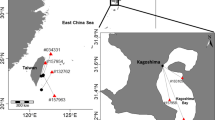Abstract
Data from 11 pop-up archival transmitting tags attached to opah (Lampris guttatus, F. Lampridae) in the central North Pacific between November 2003 and March 2005 were used to describe their vertical movement and habitat. In the subtropical gyre northwest of the Hawaiian Islands, opah generally inhabited a 50–400 m depth range and 8–22°C temperatures. They were frequently found in depths of 50–150 m at night and in greater depths (100–400 m) during the day, but were constantly moving vertically within this broad range. At night, excursions below 200 m were not uncommon and during the day they were very likely to spend some time at depths <175 m. Their vertical speeds were generally <25 cm s−1 but on one occasion an opah descended at a burst speed of 4 m s−1. Vertical habitat use by individual opah apparently varied with local oceanographic conditions, but over a 24-h period the average temperature experienced was always in the narrow range of 14.7 to 16.5°C.











Similar content being viewed by others
Notes
Hawaii longline fishery logbook summary reports http://www.pifsc.noaa.gov/fmsd/reports.php (accessed February 1, 2007).
References
Bertand A, Bard FX, Jose E (2002) Tuna food habits related to the microneckton distribution in French Polynesia. Mar Bio 140:1023–1037
Brill RW, Lutcavage ME (2001) Understanding environmental influences on movements and depth distributions of tunas and billfishes can significantly improve population assessments. AFS Sym 25:179–198
Carey FG, Robinson BH (1981) Daily patterns in the activities of swordfish, Xiphias gladius, observed by acoustic telemetry. Fish Bull 79:277–292
Grower JC (1987) Introduction to ordination techniques. In: Legendre P, Legendre L (eds) Developments in numerical ecology. NATO ASI Ser G14:3–64. Kluwer, Dordrecht
Heemstra PC (1986) Family No. 117. Lampridae. In: Smith MM, Heemstra PC (eds) Smiths’ sea fishes. Springer, Berlin
Jackson GD, Buxton NG, George MJA (2000) Diet of the southern opah Lampris immaculatus on the Patagonian Shelf: the significance of the squid Moroteuthis ingens and anthropogenic plastic. Mar Ecol Prog Ser 206:261–271
Jordan DS (1905) A guide to the study of fishes, Vol 1. Holt and Co, New York
Kerstetter DW, Polovina JJ, Graves JE (2004) Evidence of shark predation and scavenging of fishes equipped with pop-up satellite archival tags. Fish Bull 102(4):750–756
Lutcavage ME, Brill RW, Somai GB, Chase BC, Howey PW (1999) Results of pop-up satellite tagging of spawning size class fish in the Gulf of Maine: do North Atlantic bluefin tuna spawn in the mid-Atlantic? Can J Fish Aquat Sci 56:173–177
Musyl MK, Brill RW, Boggs CH, Curran DS, Kazama TK, Seki MP (2003) Vertical movement of bigeye tuna (Thunnus obesus) associated with islands, buoys, and seamounts near the main Hawaiian Islands from archival tagging data. Fish Oceanogr 12(3): 152–169
Nakano H, Okazaki M, Okamoto H (1997) Analysis of catch depth by species for tuna longline fishery based on catch by branch lines. Bull Nat Res Inst Far Seas Fish 34:43–62
Polovina JJ, Kleiber P, Kobayashi D (1999) Application of TOPEX/POSEIDON satellite altimetry to simulate transport dynamics of larvae of the spiny lobster (Panulirus marginatus), in the Northwestern Hawaiian Islands, 1993–96. Fish Bull 97:132–143
Polovina JJ, Uchida I, Balazs G, Howell E, Parker D, Dutton P (2006) The Kuroshio extension current bifurcation region: a pelagic hotspot for juvenile loggerhead sea turtles. Deepsea Res II(53):326–339
Seki MP, Polovina JJ, Brainard RE, Bidigare RR, Leonard CL, Foley DG (2001) Biological enhancement at cyclonic eddies tracked with GOES thermal imagery in Hawaiian waters. GRL 28(8):1583–1586
Acknowledgments
We thank the captains and crews of the F/V Sea Pearl and F/V Kelly Ann used to tag the opah. The Matlab scripts used in the correspondence analyses were written and kindly provided by Prof. Jean-Philippe Labat and David Pellicer, Laboratoire d’Océanographie de Villefranche, University Pierre et Marie Curie, Paris, France. This work was partially funded by a grant from the University of Hawaii Pelagic Fisheries Research Program under Cooperative Agreement NA17RJ12301 from NOAA and a grant from the Ocean Exploration Program, NOAA.
Author information
Authors and Affiliations
Corresponding author
Additional information
Communicated by J.P. Grassle.
Rights and permissions
About this article
Cite this article
Polovina, J.J., Hawn, D. & Abecassis, M. Vertical movement and habitat of opah (Lampris guttatus) in the central North Pacific recorded with pop-up archival tags. Mar Biol 153, 257–267 (2008). https://doi.org/10.1007/s00227-007-0801-2
Received:
Accepted:
Published:
Issue Date:
DOI: https://doi.org/10.1007/s00227-007-0801-2




